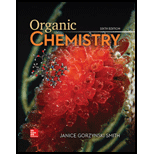
EBK ORGANIC CHEMISTRY
6th Edition
ISBN: 9781260475685
Author: SMITH
Publisher: MCGRAW-HILL HIGHER EDUCATION
expand_more
expand_more
format_list_bulleted
Concept explainers
Textbook Question
Chapter 27, Problem 61P
Draw the organic products formed in each reaction.
a. d.
d. 
b. e.
e. 
c. f.
f. 
Expert Solution & Answer
Trending nowThis is a popular solution!

Students have asked these similar questions
Please draw
9. compore the Following two Venctions IN
termy Of Ronction Rate and explan in
detail the reasoning that led to your conclusion
+He p₁₂ 11-
ㅐ 15
.. +He
H #H
H
/
H
b. Compare
the Following too reactions 14
terms of reaction Rate and explain in detail
the reasoning that led to your conclusion
Н
d-C-
tłu
Na
+2446
е
-ll +2n
"H
a.
•Write all of the possible products
For the Following ronction
А
-----
H
-
H
H
+ H₂0 H+
Н
b. in Rite the complete reaction Mechaniszn
For the Formation of each product.
·C. Suggest what Reaction conditions could
Result in each product being the major
Product of the veaction:
Chapter 27 Solutions
EBK ORGANIC CHEMISTRY
Ch. 27.1 - Prob. 1PCh. 27.1 - Problem 29.2
What form exists at the isoelectric...Ch. 27.1 - Problem 29.3
Explain why the of the group of an...Ch. 27.1 - Prob. 4PCh. 27.2 - Problem 29.5
What -halo carbonyl compound is...Ch. 27.2 - Problem 29.6
The enolate derived from diethyl...Ch. 27.2 - Problem 29.7
What amino acid is formed when is...Ch. 27.2 - Problem 29.8
What aldehyde is needed to synthesize...Ch. 27.2 - Problem 29.9
Draw the products of each...Ch. 27.3 - Prob. 10P
Ch. 27.3 - Prob. 11PCh. 27.3 - Prob. 12PCh. 27.4 - Problem 29.13
What alkene is needed to synthesize...Ch. 27.5 - Problem 29.14
Draw the structure of each peptide....Ch. 27.5 - Problem 29.15
Name each peptide using both the...Ch. 27 - Draw the product formed when the following amino...Ch. 27 - With reference to the following peptide: a...Ch. 27 - Prob. 31PCh. 27 - Histidine is classified as a basic amino acid...Ch. 27 - Tryptophan is not classified as a basic amino acid...Ch. 27 - What is the structure of each amino acid at its...Ch. 27 - What is the predominant form of each of the...Ch. 27 - 29.37 What is the predominant form of each of the...Ch. 27 - a. Draw the structure of the tripeptide A–A–A, and...Ch. 27 - 29.39 Draw the organic products formed in each...Ch. 27 - 29.40 What alkyl halide is needed to synthesize...Ch. 27 - Prob. 50PCh. 27 - Draw the structure for each peptide: (a) Phe–Ala;...Ch. 27 - 29.52 For the tetrapeptide Asp–Arg–Val–Tyr:
a....Ch. 27 - Prob. 53PCh. 27 - Prob. 54PCh. 27 - 29.55 Draw the amino acids and peptide fragments...Ch. 27 - Prob. 56PCh. 27 - Prob. 57PCh. 27 - Prob. 58PCh. 27 - 29.59 An octapeptide contains the following amino...Ch. 27 - 29.60 Draw the organic products formed in each...Ch. 27 - 29.65 Draw the mechanism for the reaction that...Ch. 27 - 29.66 Which of the following amino acids are...Ch. 27 - 29.67 After the peptide chain of collagen has been...Ch. 27 - Prob. 68PCh. 27 - Prob. 69PCh. 27 - 29.70 The anti-obesity drug orlistat works by...Ch. 27 - Prob. 71P
Knowledge Booster
Learn more about
Need a deep-dive on the concept behind this application? Look no further. Learn more about this topic, chemistry and related others by exploring similar questions and additional content below.Similar questions
- Write all of Me Possible Products For each Of the Following reactions. In each case identity all pains of enantiomers, all digsterzoners and all Meso compounds 9. 11-60 11-0-11 V-G Η Η H ~ C-11 +HB+ - 1 H b. पन्ना 171-0-11 H-C-H Н C-C=c-call +HBr Perendez ==arrow_forwardHow can i draw the mechanisms for this molecule?arrow_forwarda. Discuss and explain he difference IN Stability between the Chai and Boat Гольцу от судомехане b. For the Following Molecule draw both possible Clain conformations and explain which one is more stable and for what Reason. H. CH₂ CH₂ H "Harrow_forward
arrow_back_ios
SEE MORE QUESTIONS
arrow_forward_ios
Recommended textbooks for you
 Chemistry for Today: General, Organic, and Bioche...ChemistryISBN:9781305960060Author:Spencer L. Seager, Michael R. Slabaugh, Maren S. HansenPublisher:Cengage Learning
Chemistry for Today: General, Organic, and Bioche...ChemistryISBN:9781305960060Author:Spencer L. Seager, Michael R. Slabaugh, Maren S. HansenPublisher:Cengage Learning Organic ChemistryChemistryISBN:9781305580350Author:William H. Brown, Brent L. Iverson, Eric Anslyn, Christopher S. FootePublisher:Cengage Learning
Organic ChemistryChemistryISBN:9781305580350Author:William H. Brown, Brent L. Iverson, Eric Anslyn, Christopher S. FootePublisher:Cengage Learning

Chemistry for Today: General, Organic, and Bioche...
Chemistry
ISBN:9781305960060
Author:Spencer L. Seager, Michael R. Slabaugh, Maren S. Hansen
Publisher:Cengage Learning

Organic Chemistry
Chemistry
ISBN:9781305580350
Author:William H. Brown, Brent L. Iverson, Eric Anslyn, Christopher S. Foote
Publisher:Cengage Learning
Nomenclature: Crash Course Chemistry #44; Author: CrashCourse;https://www.youtube.com/watch?v=U7wavimfNFE;License: Standard YouTube License, CC-BY